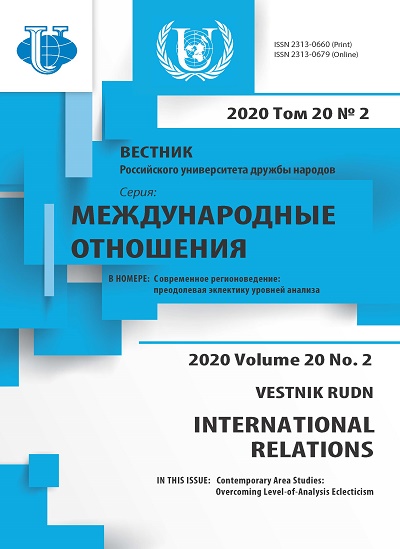International Relations in the Great Indian Ocean through the Prism of Geopolitics and Geostrategy
- Authors: Lebedeva N.B.1
-
Affiliations:
- Institute of Oriental Studies, RAS
- Issue: Vol 20, No 2 (2020): Contemporary Area Studies: Overcoming Level-of-Analysis Eclecticism
- Pages: 318-332
- Section: THEMATIC DOSSIER
- URL: https://journals.rudn.ru/international-relations/article/view/23973
- DOI: https://doi.org/10.22363/2313-0660-2020-20-2-318-332
Cite item
Full Text
Abstract
The article is devoted to an analysis of some concepts and geopolitical approaches towards the international relations in the Indian Ocean, later the Great Indian Ocean (GIO). It is the conceptual approaches that have given and give the opportunity to understand the system and structure of the IO region and to analyze the evolution, trends and practices in this system. In recent decades, the region has evolved from the mosaic of countries and the randomness of interstate relations in the first postcolonial years to a qualitatively different than before, expanded and central role in world politics and geostrategy due to new factors of the 21st century, many of which were somehow reflected in theoretical ideas of international relations (IO), proposed by Indian scholars. The article analyzes the correlation of approaches of Indian authors with Western approaches, reveals the features of Indian approaches in the context of the characteristics of the IR system of the Indian Ocean region, and identifies similarities with approaches of specialists from other Asian countries. The evolution of the concepts of Indian scientists has gone through three stages in its development. The first one is a postcolonial period till 1991, the end of bipolarity. The second is characterized by forming of the IO system under conditions of littoral states entrance in the IO scene and China intrusion in the Indian Ocean region. The essence of the third period is in transformation of the GIO IR system in force of the concept of uniting with the Asia-Pacific Region (APR) and forming Indo-Pacific megaregion.
About the authors
Nina Borisovna Lebedeva
Institute of Oriental Studies, RAS
Author for correspondence.
Email: indology@inbox.ru
PhD in History, Leading Researcher, Centre for Indian Studies
Moscow, Russian FederationReferences
- Bajpaee, C. (2017). Dephasing India’s Look East / Act East Policy. Contemporary Southeast Asia, 39 (2), 348—372. doi: 10.1355/cs39-2d
- Kaushik, D. (1972). The Indian Ocean towards a Peace Zone. New Delhi: Vikas Publication.
- Khurana, G.K. (2018). Trump’s New Cold War Alliance in Asia Is Dangerous. New Perspectives Quarterly, 35 (1), 7—10. doi: 10.1111/npqu.12114
- Khurana, G.K. (2019). What Is the Indo-Pacific? The New Geopolitics of the Asia-Centred Rim Land. In: Berkofski, A. & Miracola, S. (Eds.). Geopolitics by Other Means. The Indo-Pacific Reality. Milan: Ledizioni LediPublishing. P. 13—32.
- Kupriyanov, A.V. (2018). IBSAMAR: India’s Imperatives, Transformation Prospects. Vestnik RUDN. International Relations, 18 (3), 628—641. doi: 10.22363/2313-0660-2018-18-3-628-641. (In Russian).
- Kupriyanov, A.V. (2019). Geopolitics of the Sea: the Idea of Ocean Control in the Political Discourse of Independent India. Vestnik RUDN. International Relations, 19 (2), 234—246. doi: 10.22363/2313-0660-2019-19-2-234-246. (In Russian).
- Mallavarapu, S. (2009). Development of International Relations Theory in India: Traditions, Contemporary Perspectives and Trajectories. International Studies, 46 (1—2), 165—183. doi: 10.1177/002088171004600211
- Misra, K.P. & Naraganan, K.R. (1981). Non-Alignment in Contemporary International Relations. New Delhi: Vikas Publication.
- Mohan, C.R. (2011). The Re-making of Indian Foreign Policy. International Studies, 46 (1—2), 147—163. doi: 10.1177/002088171004600210
- Mohan, C.R. (2012). Samudra Manthan. Sino-Indian Rivalry in the Indo-Pacific. Washington: United Book Press.
- Muni, S.D. (2012). India’s ‘Look East’ Policy: The Strategic Dimensions. In: D’Souza, S.M. & Jetly, R. (Eds.). Perspectives on South Asian Security. Singapore: World Scientific Publishing Co. P. 67—99. doi: 10.1142/9789814407366_0004
- Namboodiri, P.K.S. (1981). The Indian Ocean Front. Strategic Analysis, 5 (5—6), 196—205.
- Panikkar, K.M. (1945a). India and the Indian Ocean: An Essay on the Influence of Sea Power on Indian History. New York: Macmillan Company.
- Panikkar, K.M. (1945b). Regional Organization for the Indian Ocean Area. Pacific Affairs, 18 (3), 246—251.
- Parmar, S.S. & Salil, S. (2011). China and India: Maritime Commonalities and Divergences. Journal of Defence Studies, 5 (3), 144—150.
- Poulose, T.T. (1974). Indian Ocean Power Rivalry: Analytical Study of the Littoral States Perspective. New Delhi: Young Asia Publications.
- Sen Gupta, Bh., Poulose, T.T. & Bhatia, H. (1974). The Malacca Strait and the Indian Ocean: A Study of the Strategic and Legal Aspects of a Controversial Sea-Lane. New Delhi: Macmillan.
- Sharma, R.S. (1974). The Indian Ocean and Its Community. A Geographical Approach. In: Poulose, T.T. (Eds.). Indian Ocean Power Rivalry: Analytical Study of the Littoral States Perspective. New Delhi: Young Asia Publications. P. 433—450.
- Singh, K.P. (1981). The Subcontinent Differing Perceptions. World Focus, 13, 21—25.
- Singh, K.R. (2008). Maritime Security for India. New Challenges and Responses. New Delhi: New Century Publications.
- Stephen, M.D. (2016). India and BRICS: Global Bandwagoning and Regional Balancing. Vestnik RUDN. International Relations, 16 (4), 595—602. doi: 10.22363/2313-0660-2016-16-4-595-602
- Subrahmanyam, K. (1982). Indian Security Perspectives. New Delhi: ABC Publishing House.
- Subrahmanyam, K. (1989). Arms Limitation in the Indian Ocean: Retrospect and Prospect. In: Harrison, S.S. & Subrahmanyam, K. (Eds.). Superpower Rivalry in the Indian Ocean and American Perspectives. New York: Oxford University Press. P. 223—245.
- Winner, A.C. (2008). India as a Maritime Power? In: Yoshihara, T. & Holmes, J.R. (Eds.). Asia Looks Seaward. Power and Maritime Strategy. Washington: Praeger. P. 125—146.
- Yanik, A.A. (2019). Advancement of the Indo-Pacific Concept as a Mechanism for Changing the Regional Strategic Balance: from Haushofer to Trump. Conflictology / Nota bene, 4, 64—83. doi: 10.7256/2454-0617.2019.4.31457. (In Russian).











